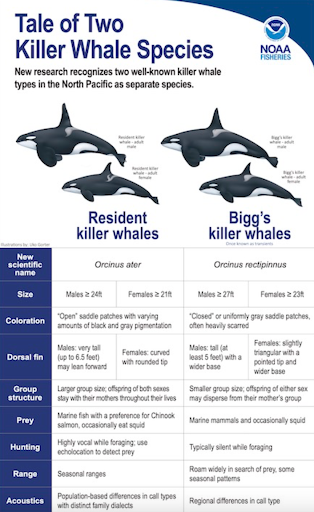Recently, three major discoveries have been made regarding Orcas or ‘The Killer Whale.’ The killer whale, or the Orcinus orca, is a large toothed whale that is a member of the dolphin family. They can grow to be around 8800 pounds and are incredibly smart. Recently scientists studying killer whales have observed many new discoveries. The most recent observation brings back information from 2020.
In 2020, a pod of Orcas began attacking boats in the waters of southwestern Europe. Recently, the same pod has been spotted circling and attacking boats off the coast of Spain, reportedly “hundreds of miles from where they should be.” The most baffling aspect of this anomaly, however, is that scientists disagree on why the Orcas have migrated.
Of local (more) relevance to CT, Orcas have been making recent appearances further up the coast around Long Island (LI). Orcas are normally spotted in colder climates, and recently random pods of Orcas have been spotted by the LI coast. These Orca pods are making food out of Long Island’s infamous Great White shark population. Interestingly, the Orcas often kill the shark and only eat its liver – the most nutritious part of the animal.
While these Orca anomalies are happening in very different parts of the world, it is likely that both of these are a result of global warming. Orcas are highly adaptable and follow their food sources. As their food sources are migrating, so are the Orcas, disrupting ecosystems as they go.
 The most exciting discovery – made this past March – is that Orcas have speciated! Recently, National Oceanic and Atmospheric Administration fisheries published an article titled: “New Research Reveals Full Diversity of Killer Whales as Two Species Come into View on Pacific Coast.” In the 1970s, late scientist Micheal Bigg noted the visual differences between two groups of killer whales. After more observation, he realized that they rarely interacted and rarely bred. As of now, NOAA has established that the two species are reproductively isolated, meaning they are definitely two distinct species: the Resident Killer Whale and the Bigg killer whale. These two subspecies also possess numerous differences. The Resident Killer whales travel in small family groups while the Bigg’s Killer whales travel in small groups as well, but they are not necessarily related. They also eat different foods. The Resident Killer whale sticks to fish while the Bigg’s Killer preys on larger sea mammals. They also have slightly different markings around their dorsal fins.
The most exciting discovery – made this past March – is that Orcas have speciated! Recently, National Oceanic and Atmospheric Administration fisheries published an article titled: “New Research Reveals Full Diversity of Killer Whales as Two Species Come into View on Pacific Coast.” In the 1970s, late scientist Micheal Bigg noted the visual differences between two groups of killer whales. After more observation, he realized that they rarely interacted and rarely bred. As of now, NOAA has established that the two species are reproductively isolated, meaning they are definitely two distinct species: the Resident Killer Whale and the Bigg killer whale. These two subspecies also possess numerous differences. The Resident Killer whales travel in small family groups while the Bigg’s Killer whales travel in small groups as well, but they are not necessarily related. They also eat different foods. The Resident Killer whale sticks to fish while the Bigg’s Killer preys on larger sea mammals. They also have slightly different markings around their dorsal fins.

Bigg’s killer whales are found along the coast from Alaska to Northern California while Resident killer whales are found from California to Russia. This suggests that, while they likely originated from a reproductive barrier, they now are geographically isolated.
These discoveries are rather monumental as, over time, Orcas have been given quite the bad reputation. They received this reputation for a variety of reasons, beginning with their alternative name. Orcas are also known as killer whales, a name that evokes fear and evil. People also may think of the death of trainer Dawn Brancheau when they think of killer whales. What people do not understand is that though these are highly intelligent animals, they are natural predators who are not used to captivity. People have also described orcas as cunning and disruptive on multiple social media platforms like TikTok, creating stories that link evil and fear with Orcas. It is quite possible this fear comes from the lack of knowledge about this intelligent creature which can be rebutted by the new discoveries about killer whales. The more people know, the less afraid they will be!
















Kay Gideon • May 13, 2024 at 7:52 am
The Orca is remarkable on many levels. I wonder if any research/study has been done about the intelligence and adaptivity between Bigg’s and Residents. The Bigg’s seem more capable of of adapting to change than the Residents.